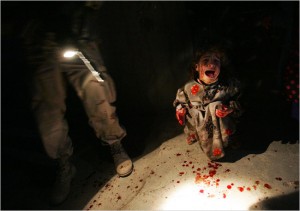 True costs of Iraq War whitewashed by fuzzy maths
True costs of Iraq War whitewashed by fuzzy maths
By Muhammad Idrees Ahmad, Apr 5, 2013
‘So many’, wrote TS Eliot, reflecting on the waste land left by the First World War. “I had not thought death had undone so many.”
This notion is unlikely to cross the minds of those surveying the devastation left by the 2003 invasion of Iraq. The most frequently quoted fatality figure – about 115,000 Iraqis killed – is shocking. But compared to major conflicts of the past century, it is a relatively modest toll. The 1916 battle of the Somme alone killed three times as many. More than that were killed by a single atomic bomb dropped on Hiroshima during the Second World War.
Former British prime minster Tony Blair, and then-US vice president Dick Cheney, were perhaps conscious of this when they expressed “no regrets” on the 10th anniversary of the war last month.
That the perpetrators of an aggressive war should accept the lowest costs for their folly is unsurprising. What is less explicable is why so many supposed critics of the war are crediting the same estimate. Brown University’s Costs of War project and the Centre for American Progress’s Iraq War Ledger use it as their main source.
This is particularly puzzling when there are two peer-reviewed epidemiological surveys that give a far more comprehensive accounting of the war’s human cost. A Johns Hopkins Bloomberg School of Public Health Survey published in the Lancet, and the Iraq Public Health Survey published in the New England Journal of Medicine, gave figures of 655,000 and 400,000 excess deaths respectively. (Both were concluded in June 2006, a month before the violence peaked, suggesting the actual toll is even higher).
It is odder still that when epidemiological surveys have come to be accepted as the standard method for estimating conflict fatalities – the method has been used without controversy in Congo, Bosnia and Darfur – an exception is made in the case of Iraq.
The method involves a household survey to establish current mortality rates and comparing them with pre-war ones. The difference, extrapolated for the whole population, yields an estimate of the number of people who would still be alive had the war not happened.
By comparison, the most commonly cited source, the UK-based online initiative Iraq Body Count (IBC), uses a passive surveillance method to estimate what it calls “violent civilian deaths”, relying mainly on media reports, initially only in the English language. Current total: between 111,842 and 122,326.
Distinguishing a civilian from a combatant in an urban war zone is itself a fraught business. But the IBC methodology makes two further assumptions that raise questions: that war kills only by violence, and that the media records every death in every part of the country.
If we accept the first assumption, then we would also have to revise our estimates of history’s other major atrocities. Those who died of exhaustion or starvation during the Nazi death marches cannot be considered casualties of war using IBC criteria since they did not die of violence. One would also have to omit those who died in the Warsaw Ghetto uprising since, by virtue of taking up arms, they forfeited their right to be counted.
War in most cases means collapse of state institutions and health care systems; it means social disintegration, food shortages and lawlessness. It kills by starvation, scarcity, contamination, shock, abandonment – and a host of other causes that don’t involve bullets. There was a four-fold increase in traffic accidents alone in the years following the invasion of Iraq. IBC’s methods make no allowances for such consequences.
The second assumption appears to ignore both Iraqi reality and media practices. No journalist made a commitment to report every death in Iraq. Most were based in politically significant locations. During the most violent period, all but a few were confined to Baghdad’s Green Zone. There is no reason to assume that every violent death, let alone every war-related death, was being reported.
Despite such limitations, IBC has become the primary, if not the only, reference for Iraqi deaths. It speaks to the political serviceability of its numbers. It also speaks to a lack of seriousness among its user about establishing the actual costs of war. The manner in which the Lancet study has been buried attests to this.
It is telling that the critics of the Lancet study are mainly journalists, politicians and bureaucrats. On the other hand, the study was endorsed by scientists, statisticians, epidemiologists and, in internal discussions, even some government officials.
The soundness of the method and the rigour of the Lancet’s research were acknowledged by Sir Roy Anderson, the British Ministry of Defence’s chief scientific adviser. In an internal memo obtained by the BBC, Mr Anderson wrote: “The study design is robust and employs methods that are regarded as close to ‘best practice’.”
One can understand the appeal of IBC for the credulous, the conformist, the cowardly or the plain ignorant. But there is no excuse for those who have allowed Iraq’s dead to be erased rather than buried.
The solemnity of even a single headstone can be a poignant warning against the folly of war. But there can’t be an epitaph on a grave that does not exist. Every Iraq dead must be counted.
Muhammad Idrees Ahmad is a Glasgow-based sociologist and the author of a forthcoming book on the Iraq war. He edits Pulsemedia.org.
http://www.thenational.ae/thenationalconversation/comment/true-costs-of-iraq-war-whitewashed-by-fuzzy-maths or http://bit.ly/XuCVaB
Photograph: https://levantium.com/2011/05/07/i-am-samar/
